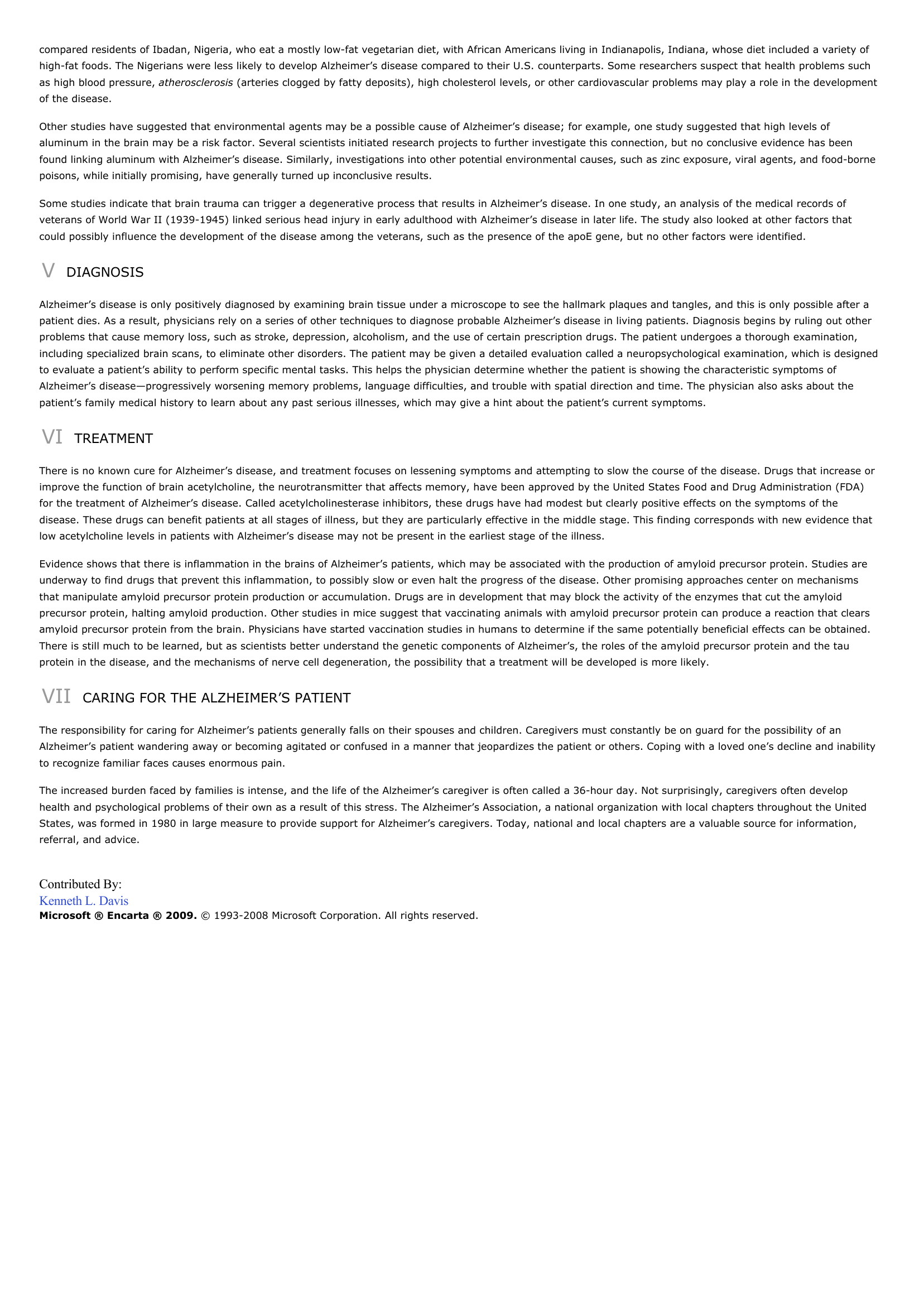Alzheimer's Disease.
Publié le 11/05/2013

Extrait du document
«
compared residents of Ibadan, Nigeria, who eat a mostly low-fat vegetarian diet, with African Americans living in Indianapolis, Indiana, whose diet included a variety ofhigh-fat foods.
The Nigerians were less likely to develop Alzheimer’s disease compared to their U.S.
counterparts.
Some researchers suspect that health problems suchas high blood pressure, atherosclerosis (arteries clogged by fatty deposits), high cholesterol levels, or other cardiovascular problems may play a role in the development of the disease.
Other studies have suggested that environmental agents may be a possible cause of Alzheimer’s disease; for example, one study suggested that high levels ofaluminum in the brain may be a risk factor.
Several scientists initiated research projects to further investigate this connection, but no conclusive evidence has beenfound linking aluminum with Alzheimer’s disease.
Similarly, investigations into other potential environmental causes, such as zinc exposure, viral agents, and food-bornepoisons, while initially promising, have generally turned up inconclusive results.
Some studies indicate that brain trauma can trigger a degenerative process that results in Alzheimer’s disease.
In one study, an analysis of the medical records ofveterans of World War II (1939-1945) linked serious head injury in early adulthood with Alzheimer’s disease in later life.
The study also looked at other factors thatcould possibly influence the development of the disease among the veterans, such as the presence of the apoE gene, but no other factors were identified.
V DIAGNOSIS
Alzheimer’s disease is only positively diagnosed by examining brain tissue under a microscope to see the hallmark plaques and tangles, and this is only possible after apatient dies.
As a result, physicians rely on a series of other techniques to diagnose probable Alzheimer’s disease in living patients.
Diagnosis begins by ruling out otherproblems that cause memory loss, such as stroke, depression, alcoholism, and the use of certain prescription drugs.
The patient undergoes a thorough examination,including specialized brain scans, to eliminate other disorders.
The patient may be given a detailed evaluation called a neuropsychological examination, which is designedto evaluate a patient’s ability to perform specific mental tasks.
This helps the physician determine whether the patient is showing the characteristic symptoms ofAlzheimer’s disease—progressively worsening memory problems, language difficulties, and trouble with spatial direction and time.
The physician also asks about thepatient’s family medical history to learn about any past serious illnesses, which may give a hint about the patient’s current symptoms.
VI TREATMENT
There is no known cure for Alzheimer’s disease, and treatment focuses on lessening symptoms and attempting to slow the course of the disease.
Drugs that increase orimprove the function of brain acetylcholine, the neurotransmitter that affects memory, have been approved by the United States Food and Drug Administration (FDA)for the treatment of Alzheimer’s disease.
Called acetylcholinesterase inhibitors, these drugs have had modest but clearly positive effects on the symptoms of thedisease.
These drugs can benefit patients at all stages of illness, but they are particularly effective in the middle stage.
This finding corresponds with new evidence thatlow acetylcholine levels in patients with Alzheimer’s disease may not be present in the earliest stage of the illness.
Evidence shows that there is inflammation in the brains of Alzheimer’s patients, which may be associated with the production of amyloid precursor protein.
Studies areunderway to find drugs that prevent this inflammation, to possibly slow or even halt the progress of the disease.
Other promising approaches center on mechanismsthat manipulate amyloid precursor protein production or accumulation.
Drugs are in development that may block the activity of the enzymes that cut the amyloidprecursor protein, halting amyloid production.
Other studies in mice suggest that vaccinating animals with amyloid precursor protein can produce a reaction that clearsamyloid precursor protein from the brain.
Physicians have started vaccination studies in humans to determine if the same potentially beneficial effects can be obtained.There is still much to be learned, but as scientists better understand the genetic components of Alzheimer’s, the roles of the amyloid precursor protein and the tauprotein in the disease, and the mechanisms of nerve cell degeneration, the possibility that a treatment will be developed is more likely.
VII CARING FOR THE ALZHEIMER’S PATIENT
The responsibility for caring for Alzheimer’s patients generally falls on their spouses and children.
Caregivers must constantly be on guard for the possibility of anAlzheimer’s patient wandering away or becoming agitated or confused in a manner that jeopardizes the patient or others.
Coping with a loved one’s decline and inabilityto recognize familiar faces causes enormous pain.
The increased burden faced by families is intense, and the life of the Alzheimer’s caregiver is often called a 36-hour day.
Not surprisingly, caregivers often develophealth and psychological problems of their own as a result of this stress.
The Alzheimer’s Association, a national organization with local chapters throughout the UnitedStates, was formed in 1980 in large measure to provide support for Alzheimer’s caregivers.
Today, national and local chapters are a valuable source for information,referral, and advice.
Contributed By:Kenneth L.
DavisMicrosoft ® Encarta ® 2009. © 1993-2008 Microsoft Corporation.
All rights reserved..
»
↓↓↓ APERÇU DU DOCUMENT ↓↓↓
Liens utiles
- Alzheimer
- Alzheimer mon amour
- tpe Alzheimer
- D3 - ENQUETES EPIDEMIOLOGIQUES EXERCICE 1 Mortalité liée à la maladie d'Alzheimer
- Alzheimer (maladie d').


